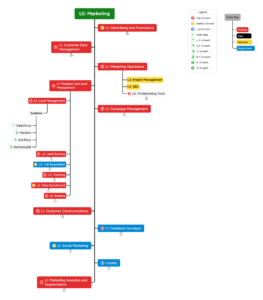What do the Chief Information Officer (CIO), Chief Marketing Officer (CMO), and Chief Revenue Officer (CRO) need from each other in order to deliver on transformative business outcomes and customer success? Certainly not more short-term fixes. Instead, they need three things:
- A cross-functional partnership
- Shared longer-term business and IT roadmaps
- Nimble architecture
“Just 36% of business users, “think IT is aligned with the needs of the business,” even though technology services are now embedded into every aspect of enterprise culture, from mobile device use to Wi-Fi access to cloud computing.” – Forbes, The 7 Deadly Sins of IT and Business Disconnect
Disconnects occur in a variety of areas: understanding each other’s offices, goals, needs, or metrics; fully realizing the function’s capabilities; finding a common/shared language; possessing the necessary skills and roles on their teams; agreeing upon how success is determined on both a macro and micro level. We could add several more.
So how can the CIO, CMO, and CRO lead the alignment of the organization and set best practices and behaviors that will transform and unlock business opportunities? Partnership. Seems straightforward, right? Let’s dig in.
Strengthen the Partnership Between the CIO, CMO, CRO
A natural partnership exists between the offices of the CIO, CMO, and CRO. They are all builders – building awareness, market share, revenues, technology solutions, and teams to support and grow the business.
However, disconnects exist. To build successful cross-business and IT partnership, we suggest addressing the challenges through a multi-phased approach.
In this post, we’ll start with the foundational steps to the partnership.
Discover and Rally Around Common Ground
Finding common ground starts by agreeing upon a common language and common outputs around goals, needs, metrics, data, visuals, definitions, business capabilities, and business outcomes. This important step starts removing some of the barriers that exist between sales, marketing, and technology.
The following steps are important steps in your success as well:
- Identify “joint champions” for IT, sales, and marketing.
-
- The sales and marketing champion collects and communicates customer and business needs for IT consumption. This role is sometimes referred to as “product marketing” and/or “revenue operations,” and brings a deeper level of market dynamics and end-user insights in a relevant subject matter area. The business champions need to understand the different technology options, the real capabilities of a solution, both the limitations and future capabilities of vendor platforms and applications, the cost and risks, and the best approach to data and integration across the different technology stacks.
-
- The IT champions need to understand the day-to-day activities of sales and marketing and the line of business and can relate technology to those needs and speak the business dialect. Often called “product manager,” or “business solution architect,” this role has deeper customer-facing and business analysis competency. This is not traditional technical project management.
- With a clear definition for your business and markets, map your current and desired business capabilities to technology. The goal here is to visualize and define a future-proof architecture that will support business priorities and KPIs.
- Lead and enable from the the top. The CIO, CMO, and CRO must enable and foster a positive, supportive environment where 360º interactions can occur across teams. Rather than viewing this as a discrete project, it should be considered from the product perspective, keeping business goals at the center of progress. Daily, weekly, and monthly cadences of formal and informal meetings supported by tools and dashboards will keep teams oriented toward the same goals. This is far less about status and more about problem/opportunity identification, data review, and joint recommendations – whether a small test or a major new initiative.
- Agree on priorities that are consumer-centered and data-backed. Consider what is ongoing and what is ad-hoc. And use the 80/20 rule to drive insights and informed decisions to naturally build those data feeds and dashboards while the greater enterprise data strategy and development is evolving.
- Use these understandings to build an actionable plan that won’t just be put on the shelf.
- Pro-actively assess your technology footprint: current state versus future/desired state.
- Map your target architecture: technology mapped to business capabilities.
- Define actionable roadmaps: constantly evolving based on business outcomes, learnings, and iteration.
- Build capabilities that support business goals and growth: equip sales and marketing teams to test, change, and build content, customer engagement, and other Martech/CRM apps; consider ways to enable and empower these users while reducing burden on IT/dev teams. (Many of these tools are SaaS/Cloud-based and are often already in use.)
“Analysts predicted the CMO would be buying $120B of tech by 2025.” – Foundation Capital, Martech and the Decade of the CMO.
- Track, measure, test, iterate, scale. Encourage some informed risk-taking as failing fast is often the way to succeed – be nimble and agile.
Foster Alignment Across Teams, Operationalize the Business+IT Partnership
Now, there is an agreed level of understanding and focus that builds alignment across your teams:
- Fosters true cross partnership with a common vision and shared language
- Allows enterprise to show and tell via Champion Initiatives (i.e., roadmap initiatives) and share measurable wins and value each quarter
-

Example current state map of business capabilities and technology
Builds understanding of key metrics for each office and what the CFO looks at, for example:
- CMO: Lifetime Value of Customer (LTV), Cost to Acquire a Customer (CAC), Retention/Churn, MQL, NPS+, etc.
- CRO: Revenue, Revenue Per Customer, Net New Revenue (New customer & Existing), Retention, etc.
- CIO/CTO: Time to Market (TMM), Uptime, Usage and QoE (Quality of Experience), SLA, etc.
- CFO: CAPEX & OPEX ROI, Revenue, Margin, Cost, Cash, etc.
- Creates alignment between desired business capabilities and the technology architecture
- Reinforces alignment behind the business strategy, business outcomes, key metrics, and customer journey success that are needed to drive and motivate the cross-functional team’s responsibilities and outcomes
Find the common ground. Empower champions within your organization. Then provide frameworks to map your business groups’ capabilities against your current technology’s capabilities. Through it all, drive a customer-centric product mindset and take the time to realize and understand each teams’ core competencies. These efforts will help to lead and motivate greater cross-business and IT partnership and, ultimately, deliver better customer journeys, business outcomes, and financial results.
And it all leads from the top with a shared relationship (and success!) between the offices of the Chief Information Officer (CIO), Chief Marketing Officer (CMO), and Chief Revenue Officer (CRO).
Leading the Way
Our healthcare, strategy, and technology experts bring vision, clarity, and deep knowledge to each important stage in this process. If you’re struggling to get started , we can help you jump start success with our Healthcare Capabilities IQ solution. Contact us to discuss your unique goals and challenges and to learn how we’ve helped some of the largest enterprises gain a 360º view of their organization’s capabilities and align to a truly partnered, consumer-centered vision and roadmap.
Sources:
The 7 Deadly Sins of IT and Business Disconnect: Forbes Article c2018
CMO buying $120BN tech by 2025 Martech and the Decade of the CMO – Foundation Capital

